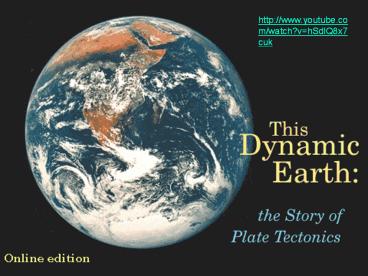Theory of Plate Tectonics - PowerPoint PPT Presentation
1 / 41
Title:
Theory of Plate Tectonics
Description:
Title: Theory of Plate Tectonics Author: Nicolas V. Bates Last modified by: Main Created Date: 3/16/2003 7:28:33 PM Document presentation format: On-screen Show (4:3) – PowerPoint PPT presentation
Number of Views:328
Avg rating:3.0/5.0
Title: Theory of Plate Tectonics
1
http//www.youtube.com/watch?vhSdlQ8x7cuk
2
The Theory of Continental Drift
3
Continental Drift Theory
- Proposed by Alfred Wegener in 1912
- 250 million years ago, all of the continents were
combined into one super-continent called
Pangaea - The continents gradually drifted apart to where
they are today
4
Evidence to Support the Theory
5
Puzzle Pieces
- Continents look like they could be part of a
giant jigsaw puzzle
6
Distribution of Fossils
- Plant and animal fossils found on the coastlines
of different continents
7
Sequence of Rocks
- Same rock patterns found in South America, India,
Africa, Antarctica and Australia
8
Ancient Climates
- Tropical plant remains (coal deposits) found in
Antarctica - Glaciation in Africa, South America, India, and
Australia during the same time
9
Problems With The Theory
- No mechanism for movement of continents
- Wind and currents could possibly move fossils
- Theory was not accepted by scientists
10
Theory of Plate Tectonics
- Plate Tectonics
- Plate Boundaries
- Causes of Plate Tectonics
11
What is Plate Tectonics
- The Earths crust and upper mantle are broken
into sections called plates - Plates move around on top of the mantle like rafts
12
(No Transcript)
13
What is the Lithosphere?
- The crust and part of the upper mantle
lithosphere - 100 km thick
- Less dense than the material below it so it
floats
14
What is the Asthenoshere?
- The plastic layer below the lithosphere
asthenosphere - The plates of the lithosphere float on the
asthenosphere
15
(No Transcript)
16
2 Types of Plates
- Ocean plates - plates below the oceans
- Continental plates - plates below the continents
17
Questions...
- What is the theory of plate tectonics?
- What is the lithosphere?
- What is the asthenosphere?
- What is the connection between the two?
- What are the two types of plates?
18
Plate Boundaries
19
Divergent Boundaries
- Boundary between two plates that are moving apart
or rifting - ? ?
- RIFTING causes SEAFLOOR SPREADING
20
Features of Divergent Boundaries
- Mid-ocean ridges
- rift valleys
- fissure volcanoes
21
(No Transcript)
22
(No Transcript)
23
(No Transcript)
24
Convergent Boundaries
- Boundaries between two plates that are colliding
- ? ?
- There are 3 types
25
Type 1
- Ocean plate colliding with a less dense
continental plate - Subduction Zone where the less dense plate
slides under the more dense plate - VOLCANOES occur at subduction zones
26
(No Transcript)
27
Andes Mountains, South America
28
Type 2
- Ocean plate colliding with another ocean plate
- The less dense plate slides under the more dense
plate creating a subduction zone called a TRENCH
29
(No Transcript)
30
Aleutian Islands, Alaska
31
Type 3
- A continental plate colliding with another
continental plate - Have Collision Zones
- a place where folded and thrust faulted mountains
form.
32
(No Transcript)
33
(No Transcript)
34
Transform Fault Boundaries
- Boundary between two plates that are sliding past
each other - EARTHQUAKES along faults
35
(No Transcript)
36
San Andreas Fault, CA
37
Questions...
- What are the three types of boundaries?
- What direction do plates go for each?
- Which boundary has a subduction zonewhat occurs
at a subduction zone?
38
Causes of Plate Tectonics
39
Convection Currents
- Hot magma in the Earth moves toward the surface,
cools, then sinks again. - Creates convection currents beneath the plates
that cause the plates to move.
40
(No Transcript)
41
Questions...
- What causes plates to move?
- How is a convection current formed?































